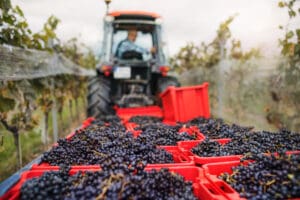Wine has always been judged through sensory experience—taste, aroma, texture. But beneath the romance of winemaking lies a logistical and biological puzzle.
Vines respond to soil, water, and climate in ways that are often invisible until it is too late. Increasingly, vineyards are using artificial intelligence to surface those hidden patterns. AI is being applied to predict stress, anticipate disease, and recommend interventions with a granularity that traditional observation cannot match.
Models are fed annotated drone footage, satellite images, and sensor readings to flag anomalies before they appear to the naked eye. In this sense, AI is less about replacing human judgment than about providing another lens. Where instinct and tradition once guided decisions on irrigation or harvest timing, vineyards are now turning to structured data as a second opinion.
Precision Labeling Brings Order to Biological Variability
Vineyards generate torrents of information: soil chemistry logs, canopy imagery, thermal maps, yield histories. The raw data is overwhelming without annotation. AI systems must be trained not only to see “stress” but to identify its location, scale, and likely cause.
This is where precision labeling has become central. Cogito Tech and Surge AI are among the firms building pipelines that can map vineyard variables such as canopy density, irrigation drift, or chlorophyll loss with spatial accuracy. Each is converging on the same lesson: agricultural AI fails when trained on generic or incomplete data. Models built on ambiguous signals may capture patterns but not actionable ones.
European vineyards, where tradition and regulation shape practice, have started integrating AI-derived stress maps into canopy and irrigation planning. The role is advisory rather than prescriptive. A grower in Bordeaux may still rely on instinct, but AI-trained overlays offer a quantified check on those instincts.
Rethinking Harvest Timing
Few decisions matter more than when to harvest. Sugar, acidity, and tannins can swing significantly in a matter of days. Historically, growers have relied on field sampling and intuition. AI systems are now being trained on years of annotated phenological data, meteorological records, and fermentation outcomes to forecast ripeness windows with far more precision.
Some models integrate drone imagery with soil health logs and historical yield data to recommend harvest timing down to specific parcels. For growers in regions where weather shifts rapidly, this reduces guesswork. The decision still rests with the winemaker, but the data offers a level of confidence that traditional methods cannot.
Traceability and Compliance
AI’s role extends beyond the vineyard into recordkeeping and regulation. Producers face growing pressure from regulators and distributors to document inputs, track treatments, and prove origin claims. Annotated datasets—covering soil treatments, pesticide use, disease episodes, and fermentation conditions—are becoming part of digital traceability pipelines.
The EU’s tightening rules on origin labeling and sustainability have made traceability not just a marketing advantage but a compliance requirement. AI systems trained on structured, labeled records can track variables across the production cycle, linking them back to outcomes in aroma, color, and mouthfeel. Firms like Cogito and others specializing in structured annotation are increasingly drawn into these agricultural projects, where transparency is as valuable as yield prediction.
The Human Element Remains Central
AI does not replicate taste. It cannot replace the intuition built over decades in a vineyard. What it can do is provide another layer of evidence in an environment shaped by climate variability and shifting consumer expectations.
Most vineyards adopting these systems are not automating decision-making. They are pairing generational knowledge with feedback loops drawn from years of local data. Winemakers are using AI outputs to confirm hunches, catch early warnings, and guide tradeoffs. The tools are becoming less about novelty and more about risk management.
The larger point is that agriculture is revealing the same pattern seen in medicine, manufacturing, and security: generic data pipelines have limited value, while context-rich, domain-annotated datasets drive meaningful performance. The companies best positioned to support this transition, whether Cogito, Surge, or others, are those that can turn biological variability into structured signals without stripping away the nuances that growers depend on.
In wine, as in other fields, AI is not displacing expertise. It is giving experts more to work with. The palate still rules the glass, but now the vineyard speaks in data long before the bottle is uncorked.
Sahana Iyer, Researcher on Human-AI Systems & Author of The Ghost in the Dataset
Read more:
How AI Is Helping Vineyards Craft Wines That Are Smoother, Richer, and Truly Memorable
















